JAPAN
Plants and Animals

Plants and Animals

Cities in JAPAN
| Kyoto | Osaka | Tokyo |
Plants ans Animals
Plants
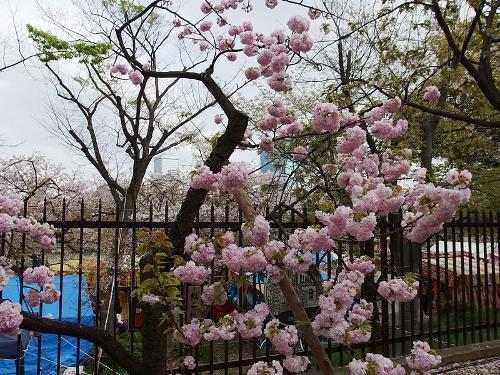 Cherry Blossom in Osaka JapanPhoto: Mc681 CC 4.0 International no changes made
Cherry Blossom in Osaka JapanPhoto: Mc681 CC 4.0 International no changes made
Japan belongs to the temperate subtropical Eurasian flora region, which means that there are many species that can also be seen in Europe. Between 200 and 500 species were introduced from Europe and the United States in the Meiji period (1868-1912).
Japan has a very rich plant world with more than 3000 species. Trees and shrubs dominate the picture, flowers much less. At present, two thirds of Japan is still covered by extensive forest areas. The many blossoms (including cherry blossoms) of trees and shrubs in the flowering periods are absolutely beautiful. There is a number of striking trees on all major islands. The Japanese cedar is the best known and can reach a length of 40 to 70 meters and also the ginkgo, a coniferous tree species with leaves (!), Camellia and bamboo (about 100 species). Maples are also quite common. Typically Japanese trees are sugi, kiri, hinoki and urushi.
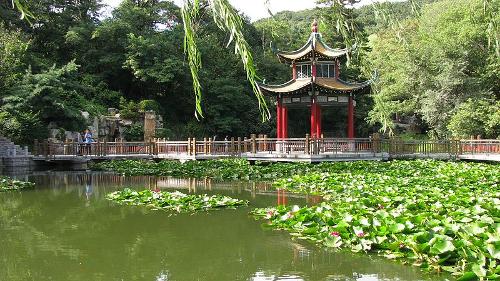 Lotus pond JapanPhoto: Jacky Lee CC 3.0 Unported no changes made
Lotus pond JapanPhoto: Jacky Lee CC 3.0 Unported no changes made
Azaleas, irises and chrysanthemums are often used in garden and park landscaping, where the Japanese are masters. The lotus ponds are striking, but the plant is also grown as a food. The bonzai trees are world famous, which in cultivated form are an imitation of the trees in the mountains formed by the harsh climate.
Kyushu is home to subtropical evergreen forests that mainly consist of oak, laurel species such as camphor, palms, pepper trees and tulip trees. Furthermore, many ferns, bamboo and orchids growing on trees. Mangrove swamps are found in the coastal regions of the southern Ryuku Islands. Yaku-shima Island, located between Kyushu and the Ryuku Islands, has cedars dating back more than 2,000 years.
The island of Honshu also has subtropical Japanese deciduous and coniferous forests that do lose their foliage. These forests are among the richest and most abundant vegetation types in the world. Various types of oak, Japanese cedar, spruce, birch, beech, hornbeam and alder grow here. Furthermore, many types of lianas, shrubs and a dense, almost impenetrable herb layer.
The forests of Hokkaido consist for the most part of coniferous trees, especially in the northern part. Furthermore, ash and birch.
Animals
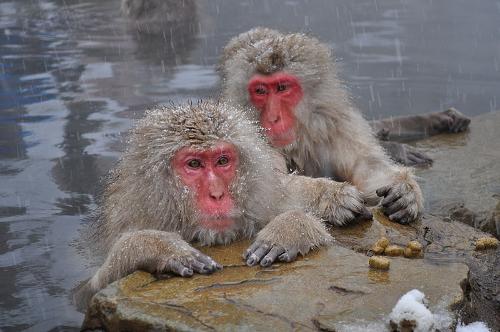 Japanese MacaquePhoto:Yblieb CC 3.0 Unported no changes made
Japanese MacaquePhoto:Yblieb CC 3.0 Unported no changes made
The Japanese animal world has many Asian elements, including the Japanese macaque, the monkey species with the most northerly distribution, the flying dog, the collar bear and the sika deer. Brown bears are found on Hokkaido.
Furthermore brown bears and a number of other predators such as foxes, weasels, stone martens, ermines, minks, badgers and the "tanuki" or raccoon dog. Various deer species and wild boars live in the middle of the country.
Cattle are hardly visible, they are kept in sheds because there is hardly any grassland. The Japanese wolf is extinct and the Iriomote cat, the Tsushima cat, the Blakiston fishing owl and the Japanese river otter are highly endangered.
The bird world is rich in species, about 450 have been counted in Japan. Cranes are found on Hokkaido. Flocks of little white herons live on the green rice fields. Seabirds include gulls, terns and auks; water birds including storks, ducks, geese and herons; birds of prey including eagles and hawks. The cormorant is trained to help with fishing. The "toki" or Japanese crested ibis used to be common, but is now almost extinct.
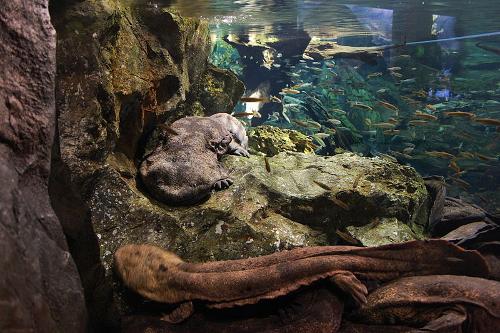 Japanese Giant SalamanderPhoto: V31S70 CC 2.0 Generic no chages made
Japanese Giant SalamanderPhoto: V31S70 CC 2.0 Generic no chages made
Reptiles and amphibians are also well represented; especially among the lizards you will find many Asian elements (geckos and skinks). The most famous amphibian is the Japanese giant salamander (Megalobatrachus japonicus), the largest amphibian in the world at almost 1.50 m in length, living mainly in Kyushu and Western Honshu. Japan has two types of poisonous snakes, including the "habu" on Okinawa. The harmless Japanese rat snake can reach a length of 1.50 meters. Many turtles live in the many ponds.
Among the freshwater fish, the cyprinids play an important role, along with salmon, trout and crayfish. In the many ponds koi are found that are bred with special color patterns.
The coastal fauna includes whales, seals and walruses. Kyushu is known for its sea turtles. Many types of fish that are used in Japanese cuisine live in the sea: especially tuna and mackerel, mullet, sardine, sea bream, herring, mullet and cod. Furthermore, crabs, shrimps, oysters and mussels.
The Japanese beetle is the most notorious of all common insects because it is able to eat an entire tree bare in fifteen minutes.
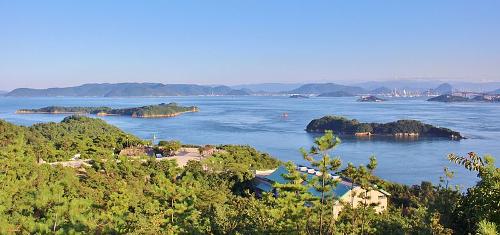 Setonaikai National Park, JapanPhoto: Yoshio Kohara CC 3.0 Unported no changes made
Setonaikai National Park, JapanPhoto: Yoshio Kohara CC 3.0 Unported no changes made
Japan has 28 national parks (kokuritsu koen) and 55 semi-national parks (kokutei koen). Most of these parks are located in the Tohoku regions of North Honshu and Hokkaido, where the population density is not so high. Nevertheless, there are also national parks in the immediate vicinity of the capital Tokyo. The largest national park is Seto Naikai Kokuritsu-koen.
Sources
Japan
Lonely Planet
Japan
Reader's Digest
Kamachi, N. / Culture and customs of Japan
Greenwood Press
Scott, D. / Japan
Van Reemst
Shelley, R. / Japan
Times Books
Somerwil, J. / Japan
Gottmer/Becht
Stefoff, R. / Japan
Chelsea House Publishers
CIA - World Factbook
BBC - Country Profiles
Copyright: Team The World of Info